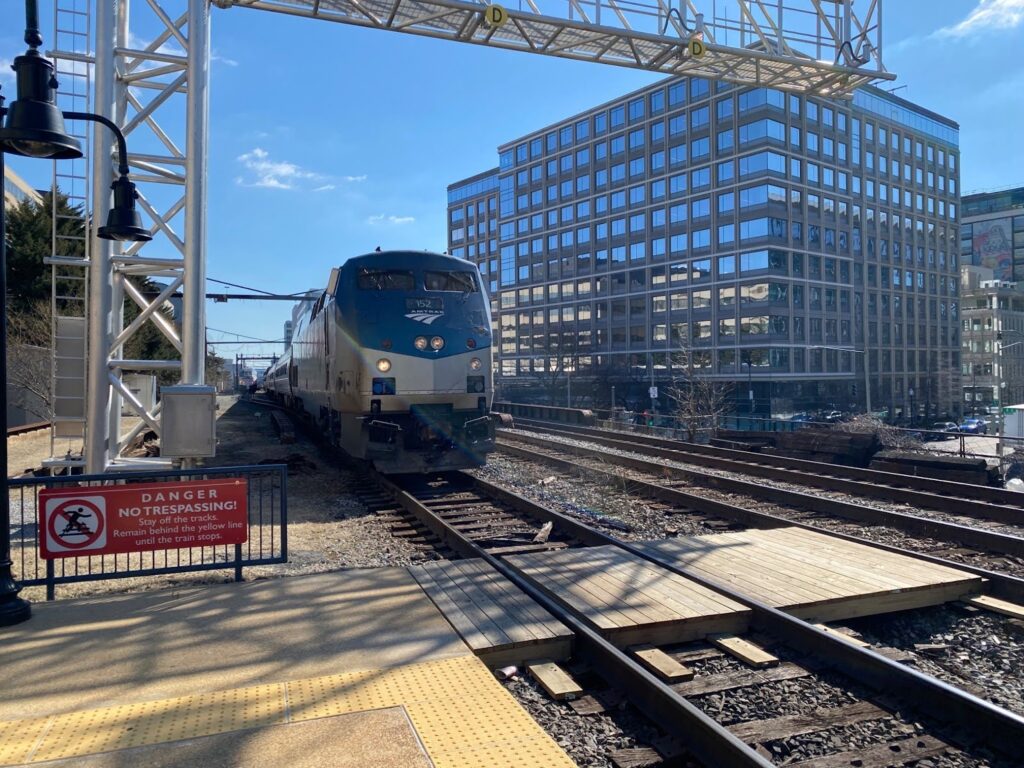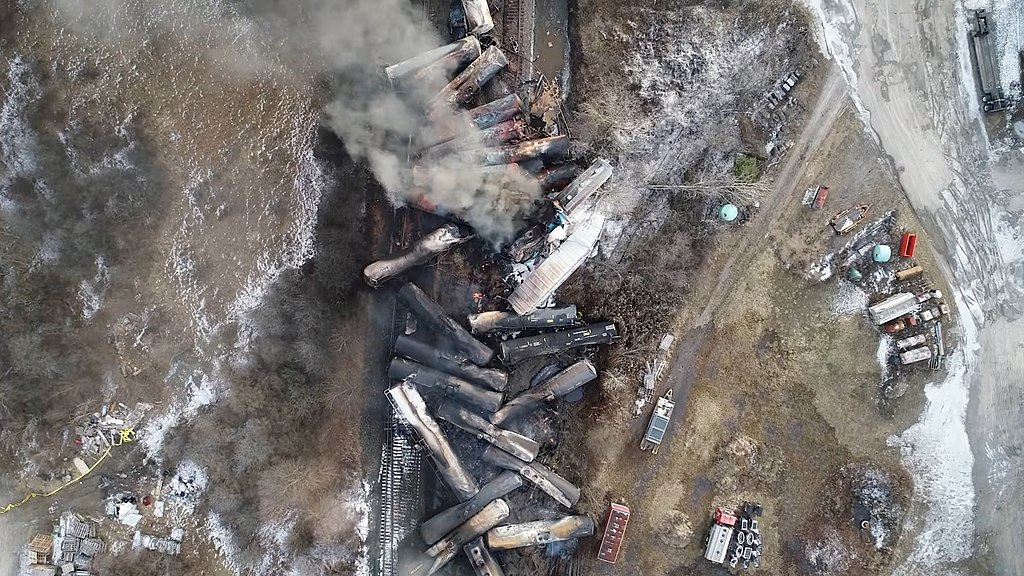
Off the rails: A call for freight railroad reform

Between all seven Class I freight railroad companies, the U.S. saw over 1,000 derailments in 2022. Norfolk Southern (the company responsible for the derailment in East Palestine) had 119 by itself. Other railways had even more, like BNSF which derailed 279 times in 2022. Derailments are harmful to the supply chain at best and record-setting environmental disasters at worst. The systemic problems within the freight industry that have led to derailments also have the side-effect of delaying passenger rail service.

Last May, we announced that the Surface Transportation Board (STB) was finally taking action to improve the on-time service and safety records of freight railroads. With the recent freight disasters in East Palestine, Ohio, Springfield, Ohio, and Calhoun County, Alabama, it would seem that the freight railroads have not learned their lesson.
“Inconsistent and unreliable rail service”
On top of the freight industry’s frequent derailments and propensity to skirt regulations, the quality of their normal service is at an all-time low. Last year the National Grain and Feed Association decried three of the largest nationwide freight carriers—Union Pacific, BNSF Railway, and Norfolk Southern—for delaying shipments, resulting in the shuttering of several flour mills and livestock facilities. These delays were also a major cause of the 2022 supply chain crisis.
To hear the Surface Transportation Board (STB) say it, the freight railroad industry provides “inconsistent and unreliable rail service” that has “continued to deteriorate” in recent years. As a result, the STB continues, “shippers cannot get their products to market on time or receive essential raw materials for their companies.” This is why shippers and their customers are some of the biggest critics of freight railroad companies.
Regulators at the Federal Railroad Administration (FRA) and STB have the power to impose safety and performance regulations on freight railroads, so why does freight continue to get away with poor safety records and low performance?
Flying in the face of regulators
The FRA is responsible for regulating the railroad industry but lacks the resources to fulfill its mandate. FRA Administrator Amit Bose, although committed to making a difference, has neither the staff nor the funding he needs to proactively regulate the freight railroads. Between responding to frequent derailments and managing a $66+ billion grant and loan program, the agency is stretched thin. FRA resources have not kept pace with their increased authority, so regulators don’t have the tools they need to push freight railroads to develop their workforce, invest in safety technology, or conduct basic infrastructure maintenance.
The freight railroad industry, in turn, has lengthened trains and reduced their workforce, a common cost-cutting practice known as precision-scheduled railroading. Railroad industry labor leaders have noted that longer trains are unwieldy and make derailments more likely. A 2019 Government Accountability Office (GAO) report found that train lengths increased across all seven Class I railroads, with some companies reporting average train lengths of 1.4 miles. The GAO, however, recommended only that FRA “work with railroads…to identify and reduce impacts of longer freight trains on highway-railroad crossings,” as FRA has little authority to do much else.
These issues are compounded by freight railroad companies’ refusal to provide basic information to federal regulators. In a filing before the STB in September, one freight railroad asserted that their rail traffic control data was confidential and proprietary and that turning it over would hinder their competitive advantage. This is simply not true, since anyone with a camera and enough time on their hands could collect most of the data that these companies claim to be secrets. But they use that line anyway, and FRA rarely has the legal authority to refute it. In the case cited above, STB only got access to the data after years of litigation.
But even when regulations exist and are enforced, they don’t work. While FRA can (and does) issue fines to freight rail companies that violate federal regulations, the penalties have little effect. Internally, freight railroad companies have long held the position that being fined by the FRA is just the cost of doing business. They factor it into their annual budgets.
Impacts on Amtrak service
Unreliable freight rail service means unreliable Amtrak service, since for the most part, Amtrak operates on tracks owned by freight companies. This problem is so pervasive that Amtrak has a dedicated page on its website to warn passengers about freight delays. They estimated that freight companies caused 900,000 minutes of delay for Amtrak passengers in 2021. Every Amtrak route outside the northeast corridor was delayed by freight trains more than 50 percent of the time in 2022.
On a personal note, I was recently on a Crescent train from DC to New Orleans to attend Amtrak’s announcement that they are pursuing new long-distance passenger rail service along the I-20 corridor from Atlanta to Dallas. But our trip was interrupted when a freight train derailed ahead of us, forcing us to disembark in Atlanta and delaying our trip.Like many passengers, I could not wait for my train to resume service, so I had to find an alternate route to my destination. I could see how that experience would make someone hesitate before riding another Amtrak train.
How can we expect to build out a national network of passenger rail if passengers cannot reliably reach their destinations even half the time? Money is not the issue. In fact, federal funding for rail remains at an all-time high. But no amount of passenger rail funding can prevent delays caused by other companies. With freight trains in the way, Amtrak is going nowhere.
Getting back on track
In recent months, federal regulators have taken some more aggressive measures to ensure safe, on-time freight rail performance. For example, the FRA recently proposed a rule that would require most trains to be staffed by at least two crewmembers. This would eliminate the most egregious instances of understaffing. But why stop there? Freight railroads—as the Biden administration has emphasized—are a crucial pillar of our national supply chain.
Recent bipartisan proposals are a good start. The Railway Safety Act introduced in the Senate by Senators Sherrod Brown (D-OH) and J.D. Vance (R-OH) and the RAIL Act introduced by Ohio Representatives in the House would tighten safety regulations: requiring two person crews, expanding the classification for highly hazardous flammable trains, and imposing bigger fines on companies that violate these rules.
But these proposals still leave FRA without the tools it needs to prevent future derailments. Congress should pass legislation granting FRA the staff, resources, and authority to proactively regulate the freight industry as the national utility and public safety hazard it is. One way to do this would be to give FRA a stronger mandate to go after “proprietary” freight railroad data.
Congress should also give Amtrak stronger authority to ensure on-time service despite freight delays on its National Network. The Rail Passenger Fairness Act (S.1500 and H.R.2937), introduced by Sen. Dick Durbin and Rep. Donald Payne, Jr. in 2021 but not passed, is a good model for future legislation.We do not need to be held hostage by freight railroads. After all, we gave them the property to build their tracks. So let’s get back on them.



